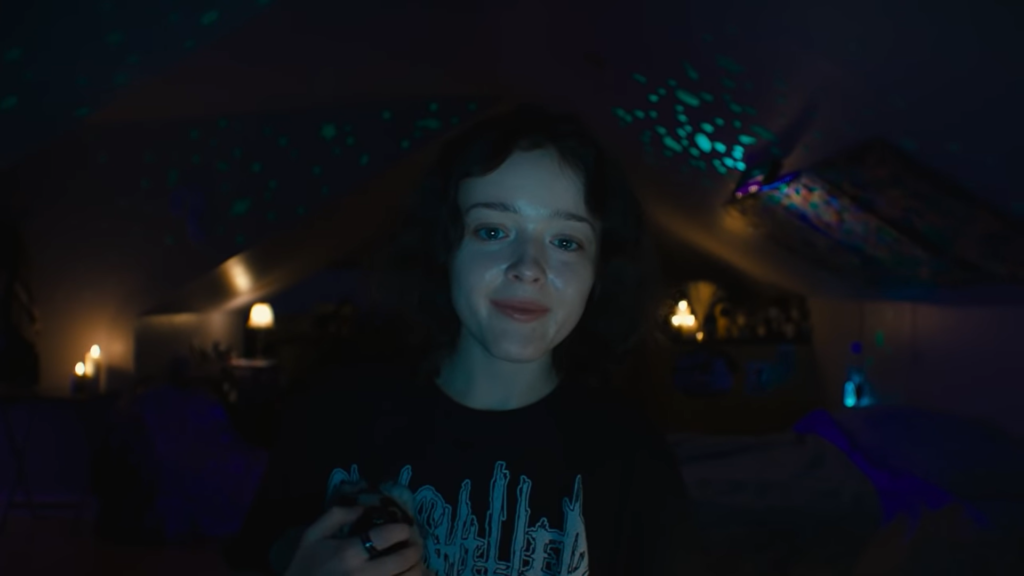We're All Going to the World's Fair
2021

Rated: R
Genre: Drama
Country: U.S.
Run-Time: 1h 26min
Director: Jane Schoenbrun
Cast
Anna Cobb…………………..Casey
Michael J. Rogers……….JLB
This is another one that is going to appeal more to the cinephiles.
We’re All Going to the World’s Fair is an American indie drama, perhaps an extremely prolific one, that was incorrectly marketed as a traditional horror film. That said, the film incorporates a lot of horror elements and is one of the eeriest film’s I have ever experienced. There is an emptiness in its atmosphere that is haunting because it captures the dark corners of a depressed person’s psyche.
Now, I will be the first to admit We’re All Going to the World’s Fair is not going to be everyone’s cup of tea. Being bombarded by image after image of lonely humans posting strange, dark videos as a way to connect is not going to be for everyone. It takes its toll. Like Skinamarink, the off-beat, experimental oddity I recently reviewed, this one is going to be a slog if you do not have the required patience needed to completely immerse yourself in the slow-burn experience.
Directed by Jane Schoenbrun, whose previous work happens to be a documentary exploring the cultural impact of Slenderman, We’re All Going to the World’s Fair is about Casey (Anna Cobb), a lonely teen making videos about the changes that occur to her after she takes an Internet horror challenge. Since the challenge isn’t real- though many probably believe it is- there should be a heavy element of roleplay in the videos she creates. But in Casey’s case the lines get blurred. Because she believes the challenge could be true, she gets caught in a loop where her invented story about being overcome by a lurking invisible evil starts to become the real thing.
It doesn’t help that one of Casey’s first videos shows the machine gun her father hides in the barn. It is quite a powerful image.
The thing I like best about Schoenbrun’s film is that there is no attempt to imply something supernatural is actually happening to Casey. Her “transformation” is either all in her head and leading her down a really dark path or else she is a real committed role-player that has control of her narrative the whole time.
And though Casey’s audience is small, she has caught the attention of one interested viewer named JLB, an older male role-player who acts out of concern for Casey while simultaneously pushing her further into her fantasy world. This exploration into the para-social relationship between Casey and JLB is at We’re All Going to the World’s Fair core- but it offers few definitive answers. Who is this man? Is he a predator or is his concern for Casey real? In a film structured around contentious truths we have reason to doubt the authenticity of all we see and hear, including the story in JLB’s final video. And why is he the one sending the film’s final video? The key to truly understanding We’re All Going to the World’s Fair is not to accept one interpretation, but to understand the many possible interpretations that Schoenbrun has put into play.
After all, how can we really know another person when all our communications are filtered through only what they want us to see?
Schoenbrun’s format for We’re All Going to the World’s Fair is innovative and tries to pull us into this strange, fictional online viewing experience.. The main narrative is pushed forward by the fictitious YouTube videos Casey creates, but there are occasional moments when the film shows the other YouTube videos that Casey and JLB are watching. In these portions of the film we see video after video of others who have been “affected” by the We’re All Going to the World’s Fair challenge. Each video helps us understand how people add their own lore to the phenomena. Some of this even influences Casey’s work.
Schoenbrun even provides a short segment from one episode of a fictitious television show to suggest that the challenge has pushed itself into popular culture. And let’s be clear, Schoenbrun is not showing us images that can only be found through a deep search into the dark web; as a director who has researched the influence of internet stories, she is showing us what often is hiding in plain sight.
Watching Schoenbrun’s invented postings reminded me a little of Zachary Donohue’s The Den, a film that has fun spoofing the content on Chatroulette. Like The Den, I found this to be the creepiest part of the film. Schoenbrun shows people who really put some effort into their videos. One man pulls ticket stubs out of rotten flesh on his arms. Another man seems to be getting mentally drowning in Tetris blocks.
But these were not the videos that lingered in my imagination after the film was over. After the credits roll, I found myself far more bothered thinking about the woman turning into plastic or the man with demon wings because their videos speak to a pain more in line with Casey’s. These people make their videos because they really do wish to transform into something else. Their videos hint at a deeply embedded psychosis rooted in body image and identity issues. The underlying sadness is suffocating. Who are these people? What does it mean about us as a society that people feel the need to make these types of videos to reach out into the world? And what does it say about others who watch these cries for help as entertainment?
The mirror We’re All Going to the World’s Fair holds up to some corners of the Internet is not a flattering one.
And the soundtrack, brought to us by folk indie rocker Alex G, is mesmerizing.
The internet can be a pretty scary place. I am surprised that the web-based movies that have been the most popular seem to be about supernatural horrors instead of the more grounded creepiness found in We’re All Going to the World’s Fair. Perhaps films like We’re All Going to the World’s Fair hit a little too close to home. Here, mental illness is not depicted as funny or as something that is included for our amusement. This is a modern horror that can be hard to watch at times because it requires you to think about social horrors that are real and how ineffective society has been at reacting to them.
